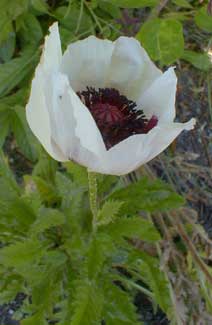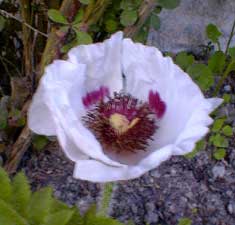
'Royal Wedding'
Perennial Poppy
"The poppies that in Spring I sow,
In rings of radiance gleam & glow,
Like lords & ladies gay.
A joy are they to dream beside,
As in the air of eventide
They flutter, dip & sway."
-Robert William Service
(1874-1958)
(1874-1958)
 The poppy Papaver orientale 'Royal Wedding' has large fluffy crepe-papery shimmering white petals with purple-black hearts, in May & June. The foliage may die back a little or a lot in the hottest days of summer, but returns in autumn for a half-fern/half-sticker looking clump of very pretty winter foliage.
The poppy Papaver orientale 'Royal Wedding' has large fluffy crepe-papery shimmering white petals with purple-black hearts, in May & June. The foliage may die back a little or a lot in the hottest days of summer, but returns in autumn for a half-fern/half-sticker looking clump of very pretty winter foliage.Placement in the garden is typically suggested to be midway back in the garden, so that the leaves won't be seen when they begin to yellow & die back in summer. My own thinking is they can be just as nice in the front of the garden for the sake of the beautiful foliage in autumn, winter, & spring. When summer dormancy begins turning the leaves yellow, they can be trimmed back.
We have five clumps of 'Royal Wedding' growing on the edge of a raised bed on the roadside, in front of daylilies & phlox. When the other perennials are dying back, the poppies' furry ferny presence is quite pleasing, & when the poppy leaves are homely in summer, the phlox & daylily foliage pretty much hides the scruffy poppies.
Poor light soil is best if the goal is to keep the foilage minimal without loss of flower-power, but foliage growth is more vigorous in humusy soil. In poor soil the flowers may remain more upright, whereas in rich soil the flower stems will be longer & fountain downward in the direction of the most sun.
Though liking full sun best, we've had them bloom excellently in light shade. They grow well under eaves out of the rain, as dryish soil is to their liking, & sharp drainage is essential.
They are difficult for flower arranging because when fully opened they quickly fall apart, & even left in the garden, 'Royal Wedding' more quickly falls apart than other varieties of perennial poppies. But if one wishes to attempt to use them as cut flowers, they should be taken early in the morning before new blooms have fully opened, & allowed to finish opening in the bouquet. They'll last at least the full day if not knocked about. In the main, however, it is best to skip past them when cutting bouquets, but later on the seedheads can be taken, dried, & used for dry flower arranging.
Every few years the clump can be dug up, divided, & replanted in September or October. The shock of division occasionally causes it to skip a year blooming. A big old clump can also be divided into many very small starts, & protected in small pots until they are big enough to put into their permanent locations the following autumn.